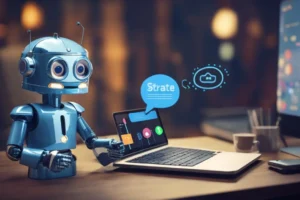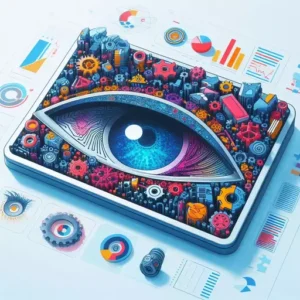Natural language processing (NLP) and machine learning (ML) are two of the most talked-about technologies today. But what exactly do they mean, and what sets them apart? In this in-depth guide, we’ll explore Natural language processing vs machine learning, look at where they intersect, and understand how they enable groundbreaking innovations across industries.
What is Natural Language Processing?
First, let’s demystify NLP.
NLP refers to techniques that allow computers to understand, interpret, and manipulate human language. Whether it’s spoken or written, NLP is all about enabling machines to comprehend the nuances of natural language to complete useful tasks.
The overarching mission of NLP is to bridge the gap between human communication and computer understanding. Rather than having to learn complex computer code, NLP allows us to communicate with technology using simple, conversational language.
Some common NLP capabilities include:
- Sentiment analysis – detecting emotion and opinions in text
- Machine translation – automatically translating languages
- Speech recognition – transcribing spoken language to text
- Text summarization – creating abridged versions of long texts
- Chatbots – building systems that can converse with humans
NLP relies heavily on machine learning techniques to impart human-language understanding to machines. However, the overarching goal is centered firmly on language processing in particular.
Under the hood, NLP employs various algorithms and models to parse text data. Key tasks include:
Tokenization
This involves splitting long strings of text into smaller units called tokens. Tokens can be individual words, phrases, or even sentences. Tokenization allows NLP systems to systematically analyze linguistic components.
Lemmatization
Lemmatization maps each word to its linguistic root or lemma. This allows the system to recognize that words like “talking”, “talks”, and “talked” all derive from the root word “talk”. Grouping words by lemma helps the computer better understand meaning.
Removing stop words
Stop words like “a”, “and”, “the” carry little meaning, so NLP models are trained to filter them out. This declutters text and highlights meaningful keywords.
Part-of-Speech Tagging
Here, NLP labels each token with its grammatical function. Verbs, nouns, adjectives, and adverbs can be identified. This provides grammatical context.
Named Entity Recognition (NER)
NER focuses on pinpointing “named entities” – names of people, organizations, places, dates, and more. Recognizing these nouns gives NLP models greater comprehension.
Dependency parsing
This analyzes the grammatical structure of sentences to map out relationships between words. Useful for identifying subjects, objects, and predicates.
Mastering these and other core NLP tasks allows computer systems to truly understand text meaning at a level near human capability. It serves as the foundation for many practical NLP applications.
A Look at Machine Learning
Now let’s explore machine learning, the “brains” behind NLP…
While NLP is focused on language, machine learning is a much broader field of artificial intelligence. It involves creating algorithms and statistical models that allow computers to perform tasks effectively without explicit programming.
Instead of relying on hard-coded rules, machine learning models are trained using large sets of example data. They learn inductively from these examples to uncover patterns, relationships, and insights the programmers themselves may not have realized.
The key advantage is that these machine learning models continue to refine their understanding of the problem space through experience. The more data they ingest, the better they get at specialized tasks like prediction, classification, and ranking.
Some common machine-learning approaches include:
- Supervised learning – Models are trained on labeled data, providing examples of correct outcomes. Common for classification tasks.
- Unsupervised learning – Models must find hidden patterns and groupings within unlabeled, uncategorized data. Used for clustering and association mining.
- Reinforcement learning – Models learn through trial-and-error interactions with dynamic environments. Well-suited to robotics, and games.
- Deep learning – Multi-layered neural networks that can uncover very complex patterns in large, high-dimensional data. Excels at computer vision, NLP, and more.
So in summary, machine learning is not limited to any domain. It provides a toolkit of algorithms to uncover insights, patterns, and relationships within data of all types and sizes. Language data is just one application area for ML techniques.
How To Run Powerful LLMs Locally: A Simple Guide
Where NLP and Machine Learning Intersect

Now that we’ve covered NLP and ML independently, let’s discuss where these two key technologies intersect.
While NLP and machine learning have distinct objectives, they often work remarkably well together. NLP relies heavily on machine learning techniques to accomplish many of its goals.
Here are some examples of how NLP leverages ML:
- Speech recognition – Statistical ML models can translate speech into text more accurately than rule-based approaches. Recurrent neural networks power modern speech recognition.
- Machine translation – NLP uses ML sequence-to-sequence models to translate text between languages. Large parallel corpora train the models.
- Sentiment analysis – Text sentiment analysis is framed as an ML classification problem. Algorithms label text as positive, negative, or neutral based on training data.
- Chatbots – The natural language capabilities of chatbots are enabled by ML techniques like word embeddings, LSTM networks, and more.
On the flip side, machine learning also benefits from NLP. Whenever an ML model needs to work with speech or text data, NLP provides the required language processing capabilities. Some examples:
- Text classification – Tasks like spam detection rely on NLP to transform text into informative numerical features the ML algorithm can understand.
- Summarization – NLP techniques identify key sentences and linguistic features needed to generate automatic text summarization in ML models.
- Question answering – QA systems use NLP for tasks like named entity recognition before applying ML to retrieve answers from text.
So in practice, NLP and machine learning work together as two sides of the same coin. NLP provides ML models with an understanding of human language. ML gives NLP systems improved learning capabilities.
Real-World Applications
To better appreciate the symbiotic relationship between NLP and ML, let’s look at some real-world applications relying on both:
Intelligent Virtual Assistants

Virtual assistants like Amazon Alexa, Apple’s Siri, and Google Assistant have become ubiquitous. Users can ask them questions, give them commands, and have natural conversations.
These systems integrate both NLP and ML technology:
- NLP performs tasks like speech recognition, named entity extraction, and intent classification.
- ML selects the appropriate response from many possibilities and improves performance over time.
Together, NLP and ML make virtual assistants feel more human-like and adaptive.
Sentiment Analysis
Sentiment analysis is used to automatically evaluate opinions, emotions, and attitudes within textual data. It has applications in marketing, politics, and beyond.
- NLP techniques identify parts of speech, grammatical relationships, and subjective vs objective language.
- ML classifies text snippets as positive, negative, or neutral based on NLP-extracted linguistic features. Sentiment lexicons help tune the models.
This combination enables robust and nuanced analysis of sentiment at scale.
Machine Translation
Services like Google Translate can near-instantly translate text between thousands of language pairs.
- NLP provides rules-based translation, word sense disambiguation, and transliteration capabilities.
- ML compares large bilingual text corpora to uncover translation patterns, generating more accurate phrase-based translation.
Together, NLP and ML in machine translation reduce errors and provide context-aware, human-quality translation.
As these examples illustrate, NLP and ML each contribute specialized capabilities that allow tackling complex language processing tasks with greater fluency and precision.
Key Differences Between NLP and ML

While NLP and machine learning work hand-in-hand, they have some key differences that set them apart:
Languages vs Data
NLP focuses specifically on processing and generating human languages – for example, English, Chinese, and Arabic. Machine learning is much broader – it can process any type of structured or unstructured data.
Rules vs Patterns
Some NLP techniques still rely on linguistic rules crafted by linguists. Machine learning is more statistical – it looks for patterns within large datasets without human guidance.
Accuracy vs Fluency
For ML, performance metrics emphasize accuracy, precision, recall, and F1-score. NLP also values fluency – how coherent, natural, and human-like the language output is.
Finite vs Open-domain
NLP systems are designed for narrow, finite tasks like translation, question-answering, etc. ML can be applied much more broadly across virtually any industry or domain.
Language Resources
NLP training data includes dictionaries, ontologies, word embeddings, parsers, etc. ML uses more generic tabular datasets, time series data, images, videos, and sensor data.
So in summary, think of NLP as a specialized application of ML focused exclusively on human language tasks. NLP also places more emphasis on linguistic knowledge and fluency.
A Look at Common Algorithms

NLP and ML also leverage some distinct algorithms and modeling techniques:
Common NLP Algorithms
- Word2vec / GloVe – Creates word embeddings carrying semantic meaning.
- Latent semantic analysis – Analyze relationships between documents and terms within a corpus.
- BERT (Bidirectional Encoder Representations from Transformers) – Transformer model that learns contextual word representations.
- ELMo (Embeddings from Language Models) – LSTM model for deep contextualized word representations.
Common ML Algorithms
- Linear regression – Predicts numerical values based on linear correlation with features.
- Logistic regression– Categorizes textual data using regression. Useful in NLP.
- Random forests – Ensemble method combining predictions from many decision trees.
- Support vector machines – Maximize the margin between different categories of data.
- Neural networks – Model complex nonlinear relationships for tasks like translation and speech recognition.
As you can see, NLP tends to leverage more language-specific embedding models like BERT and ELMo. ML offers a broader toolkit not limited to just text data.
Evaluation Metrics
We evaluate NLP and ML models using somewhat distinct metrics:
NLP Metrics
- BLEU – Compares machine-to-human translations through n-gram matching.
- ROUGE – Measures quality of automatic text summarization against references.
- Accuracy – Correctly completed tasks as a percentage of the total.
- Perplexity – For language models, how confused the model is by text. Lower is better.
ML Metrics
- Accuracy – Portion of correct predictions over total predictions.
- Precision – Of all predicted positives, how many were positive?
- Recall – Of all actual positives, how many did we predict correctly?
- F1 score – Harmonic mean of precision and recall.
- Mean squared error – Difference between predictions and true values.
Again, NLP focuses more on natural language fluency, while ML optimizes for maximum predictive accuracy. The needs of each domain lead to different performance metrics.
A Brief History
While contemporary NLP and ML are entwined, they arose from different origins.
NLP History
NLP has roots in linguistics and computer science. Early NLP work focused on programming computers to understand language using hand-written grammar rules. SHRDLU, ELIZA, and PARRY were influential early NLP chatbots exhibiting some language comprehension.
The 1980s saw a shift towards statistical NLP based on machine learning. Corpus linguistics provided datasets needed to train statistical models. This led to advances in speech recognition and machine translation.
More recently, NLP has benefited enormously from the rise of deep learning. Neural network architectures like RNNs, LSTMs, and transformers have achieved new milestones in language generation and understanding.
ML History
Machine learning grew out of pattern recognition research focused on designing statistical models for tasks like classification. Early machine learning concentrated mostly on structured numerical data.
In the 1990s and 2000s, machine learning gained more mainstream adoption. Algorithmic advances and computing power improvements made complex ML models practical. The field enjoyed success in applications like computer vision and bioinformatics.
Deep learning emerged as a dominant ML paradigm in the 2010s after TPUs and GPUs enabled efficient training of multilayer neural networks on vast datasets. Besides NLP, deep learning drove progress in many business and scientific domains.
Today, easy-to-use ML frameworks like TensorFlow and PyTorch provide access to powerful AI capabilities to a broad community. The stage is set for ML to transform how future applications leverage data.
While separate historically, contemporary NLP and ML now evolve together in lockstep. Progress in one field often parallels advancements in the other. This synergistic growth seems poised to continue accelerating.
NLP and ML in the Real World
Beyond the technical details, it’s worth exploring the real-world impact NLP and ML are having:
Digital Assistants
NLP-powered chatbots allow us to interact with technology through natural speech and increasingly natural conversations. Meanwhile, ML personalizes responses and recommendations to each user. Together, they are making digital assistants like Alexa more helpful day by day.
Fighting Misinformation
NLP can rapidly scan news, social media posts, and other text data to flag misinformation and distorted facts. ML goes further to track how falsehoods spread through closed groups. Together they form a potent tool for fighting misinformation.
Tailored Healthcare
In medicine, NLP interprets doctors’ notes and electronic health records to reveal insights about patients and treatment efficacy. ML can then tailor care plans and medication dosages to individuals’ needs and risk factors.
Smarter Cybersecurity
NLP helps teach AI systems to parse the colloquial language often used in online forums and the dark web. This allows ML algorithms to detect emerging cyber threats by analyzing community discussions.
Across sectors, NLP and ML are each playing to their strengths to open up new possibilities. Though still emerging, their societal impacts are already profound and growing.
The Future of NLP and ML
Given the rapid pace of innovation, what might the future look like for NLP and ML?
Here are some exciting directions these fields are expanding:
- Conversational AI – Continued progress in making virtual agents more natural and conversational. Useful for customer service and as personal assistants.
- Multilingual models – Models capable of serving users across a growing number of languages. Breaks down language barriers.
- Generative text – Models that create original text for uses like content creation and code generation.
- Robust training data – Techniques like synthetic data hold promise for training ML models with less human-labeled data.
- Explainable AI – Improving model interpretability to build appropriate trust in AI systems.
- Ethical AI – Fairness, transparency, and accountability will grow as a focus in human-AI interaction.
Together with adjacent fields like computer vision and robotics, NLP and ML are poised to fundamentally reshape society and industry. However, increased public awareness and governance of these powerful technologies will be needed as adoption grows.
The future is undoubtedly bright. However, increased focus on ethics and human values will help us shape it responsibly.
Key Takeaways: Natural language processing Vs Machine learning
Let’s recap some key learnings on where natural language processing and machine learning converge and diverge:
- NLP focuses on enabling computers to understand and process human languages, while ML has a much wider scope applying across diverse data types.
- NLP relies extensively on ML techniques to accomplish many language-related tasks like translation and sentiment analysis.
- ML models often employ NLP for necessary language understanding whenever they work with text or speech data.
- While their objectives differ, NLP and ML work symbiotically together in many AI applications and systems.
- NLP emphasizes linguistic knowledge and fluency, while ML optimizes for maximizing predictive accuracy across data.
- Progress in NLP often parallels advancements in ML models and vice versa in an ongoing virtuous cycle.
Understanding this intricate dance between NLP and ML provides insight into their inner workings and future directions. Their convergence will continue fueling innovation at the leading edge of artificial intelligence.
Conclusion
In this guided tour, we dove deep into natural language processing and machine learning – two cornerstone technologies of artificial intelligence. We explored their unique strengths and capabilities, areas of convergence, real-world impacts, and exciting frontiers.
Key learnings included:
- NLP imparts language understanding onto machines through techniques like named entity recognition and sentiment analysis.
- ML optimizes predictive accuracy by uncovering signals and patterns within all types of data.
- The symbiosis between NLP and ML enhances applications like search, recommendation systems, and medical diagnostics.
- New frontiers like generative text, multilingual models, and explainable AI.
Though distinct disciplines, NLP and ML work better together than alone. Their lockstep progress expands what’s possible at the intersection of human language and statistical learning.
NLP allows us to communicate and connect with technology using natural language. ML helps machines adapt through experience to serve us better each day. Together, they promise to enhance our lives and society if guided ethically.
One Response